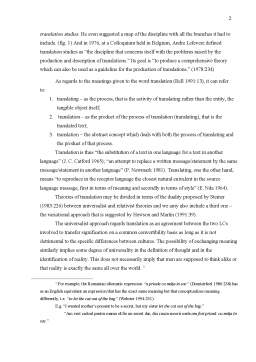Extras din referat
I chose to start with G. Steiner’s assertion (1983:78) who said that “translation exists only because people talk different languages. In fact, this truism is based on a situation that we can consider mysterious and that raises a question of both psychological and socio-historical difficulty. Why must the human beings talk thousand of different languages that cannot be understood by everyone?” Thus, “within one language or even more than one language, communication between humans is possible due to translation”(Steiner 1983: 25).
This is why a history of translations does not lack significance when trying to demonstrate their high importance for the development of cultures. Translations, as Rodica Dumitru (2002:17) notices, “have accelerated cultural progress by shortening the accumulation time necessary for the outgrowth and ripening of each culture” and as remarked by Romul Munteanu (1986:31) “scientists, artists and philosophers had noticed since early times that translations were absolutely necessary and consequently they could not be taken as superfluous ornaments in the cultural life pf any country.”
According to The Wordsworth Encyclopaedia (1997:2157) in literature translation is “the rendering of words from one language into another”. The first recorded named translator was Livius Andronicus, who translated Homer’s Odyssey from Greek to Latin in 240 B.C.
We should take into account the fact that translation theory is the traditional name that was given to the general knowledge about translation and nowadays, it has become an obsolete term as it is associated with the old, normative, prescriptive writings on the ways in which good literary translations could be achieved (e.g. writings belonging to such authors as Martin Luther/ 1530, Etienne Dolet/ 1540, John Dryden/ 1680, Alexander Tytler/1792 or 20th century’s Walter Benjamin/1925, George Steiner/ 1975, Louis Kelly/ 1979 etc.
However, the progress recorded in linguistics in the 1960’s led to a science of translation as shown in Eugene A. Nida’s Towards a science of translation (1964). Wolfram Wills used a similar terminology and in 1993 Gentzler’s use of the plural term translation theories reflected the diversity of contemporary trends in translation. It was James Holmes (1972- the 3rd International Conference of applied linguistics in Copenhagen – The Name and Nature of Translation Studies) that introduced that term which is widely accepted nowadays, i.e. translation studies. He even suggested a map of the discipline with all the branches it had to include. (fig. 1) And in 1976, at a Colloquium held in Belgium, Andre Lefevere defined translation studies as “the discipline that concerns itself with the problems raised by the production and description of translations.” Its goal is “to produce a comprehensive theory which can also be used as a guideline for the production of translations.” (1978:234)
As regards to the meanings given to the word translation (Bell 1991:13), it can refer to:
1. translating – as the process, that is the activity of translating rather than the entity, the tangible object itself;
2. translation – as the product of the process of translation (translating), that is the translated text;
3. translation – the abstract concept which deals with both the process of translating and the product of that process.
Translation is thus “the substitution of a text in one language for a text in another language” (J. C. Catford 1965); “an attempt to replace a written message/statement by the same message/statement in another language” (P. Newmark 1981). Translating, one the other hand, means “to reproduce in the receptor language the closest natural euivalent in the source language message, first in terms of meaning and secondly in terms of style” (E. Nda 1964).
Theories of translation may be divided in terms of the duality proposed by Steiner (1983:226) between universalist and relativist theories and we amy also include a third one – the variational approach that is suggested by Hewson and Martin (1991:39).
The universalist approach regards translation as an agreement between the two LCs involved to transfer signification on a common convertibility basis as long as it is not detrimental to the specific differences between cultures. The possibility of exchanging meaning similarly implies some degree of universality in the definition of thought and in the identification of reality. This does not necessarily imply that men are supposed to think alike or that reality is exactly the same all over the world.
Preview document
Conținut arhivă zip
- Views on Translation.doc

















